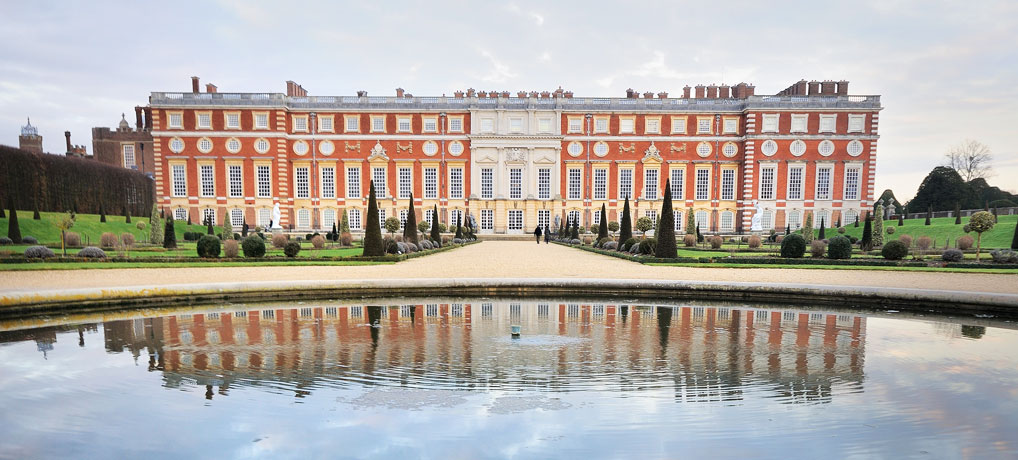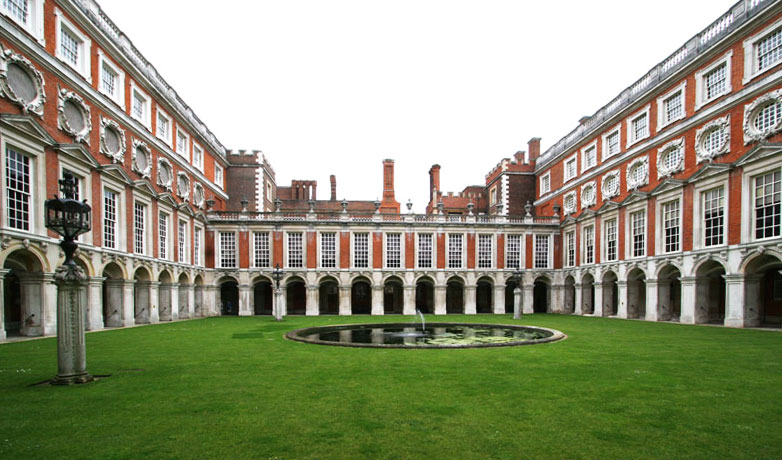One supposes Wolsey knew what was in the wind, promotions of the kind he experienced don’t happen in secret, nor overnight. He consulted with his physician (who possibly had connections with the Hospitallers) on the healthiest building location, and only four months after he was appointed Archbishop of York, Wolsey in January 1515 signed a 99 year lease on Hampton Court; he and the prior of the Hospitallers’ Order, Thomas Docwra, were fellow councilors, and must surely have discussed Wolsey’s plans long before the lease was signed, and doubtless more than one visit was paid to the site.

The family background is unclear, Wolsey’s father is variously described as a butcher, as a merchant of distinction, or as a gentleman who died a noble death on Bosworth Field – it is suggested much of the detail was invented after the fact either to enhance or detract from Wolsey’s image. Whatever his father was, there seems to be no explanation for Wolsey’s creative talent. Hampton Court is his best known but is only one of several major buildings he founded.
Wolsey was considered remarkably talented as a schoolboy in Ipswich where he was born, and at a young age he proceeded to Magdalen College, Oxford, approximately 1485, was BA at fifteen and then obtained his MA; by 1500 he was the College bursar. This background is of significance to his rebuilding of Hampton Court, which with the aid of his architect, Ellis Smith, is conceptually modeled on an Oxford University college. Although the courtyard was preserved, the previous manor house was essentially demolished, and replaced with a double courtyard palace built of a pleasantly coloured red brick, lit by mullioned windows, with a large complex of kitchens, conduits and sewers, decorative complex chimneys, highly attractive gardens, and the last moat dug in England.
There is no textbook definition of palace as compared with manor house, but Wolsey had every intention to leave definitions unnecessary, and set about the creation of a palace that would be unrivalled in England. He was well aware of buildings in Europe, of the palaces of cardinals and popes, and intended his would be in style with the best of modern design, and would no longer represent what we know now as “Tudor.” His plans were not merely to have a large building for ego satisfaction, there were also practical purposes. He wanted to be able to entertain the King in a manner more grand than he could arrange for himself, more grand than he would experience in any other palace in England; he wanted to be able to entertain visiting foreign dignitaries and impress them with his style of life in England; and of necessity, he wanted to be able to house his own staff which eventually numbered 500 persons.
It is often remarked that dignitaries in the mediaeval period were likely to have several houses, much like film stars of today, but at that time the purpose had less to do with escaping the weather and more to do with escaping the consequences of travelling with several hundred retainers who in a short period of time had eaten all that was available and had filled to overflowing the non-flush toilets, known to them as garde-robes. Imagine the amount of food going in (and out) when the French ambassador stayed with his retinue of 400, and Wolsey’s staff was at least 500!
The lease was signed in 1515, and by 1517 the new Hampton Court was fit for King Henry and Queen Catherine to visit and stay with Wolsey, and by 1525 the works were considered completed.
The approach to Wolsey’s palace was by river, as it had always been, and not as it is today by road. There was first the Watergate, then the Great Gatehouse at the river end of today’s enormously expanded complex. The moat was ornamental if not practical, but it was de rigeur for dwellings of importance to have a moat. A short fixed wood bridge led from the Outer Green Court across the moat, there never was a drawbridge nor the portcullis to be found in older castles.

The Great Gatehouse that Wolsey had built is now a shadow of its former self. There is a central pillared archway, the dwellings part of the Gatehouse is now of three stories, but in Wolsey’s day there were five stories, and the turrets at each side which are now uncapped were surmounted by lead cupolas bearing golden weathervanes.
Wolsey spent huge sums not only on the building of his palace but also on the furnishings. The walls of the rooms in the Gatehouse were covered with tapestries, which quite apart from their decorative value were a practical way of keeping out the cold. This archway leads into the expanse of the Base Court, which originally was cobbled but otherwise appears now as it did in Wolsey’s day. From the sides of this court passages lead to the 40 apartments where courtiers and guests were lodged, each with an outer and inner room, and its own “ensuite” garde-robe.
At the further end of the Base Court is another, but less spectacular gatehouse, assuredly not known to Wolsey by today’s name of Anne Boleyn’s Gateway; one supposes Wolsey was satisfied to have an ornate gateway and didn’t think it needed a name – after all, it wasn’t a dog or a child and which of us gives a name to the doorways in our house? The small turrets either side of the gateway were built in Wolsey’s time but the bell turret was not. Of interest, although this bell tower was not there in Wolsey’s day, one of the bells is dated 1480, from the Hospitaller era, and bears the initials of its fabricator, Thomas Harris.
At the inner sides of the gateway are some of the eight terra cotta medallions imaging Roman emperors made for Wolsey by the Italian sculptor Giovanni da Maiano, naming himself after his village near Florence. There is a letter from Giovanni, dated 1521, asking Wolsey for payment – Maiano charged Wolsey £2.6.8d each – plus 20 shillings each to install them. He described the medallions as painted, gilded, and representative of the exploits of Hercules. Recent restoration work at Hampton Court has found to everyone’s surprise the medallions were made from London clay, like any common house brick. It was assumed they had been made and been shipped from Italy, but the forensic analysis of minute particles of the clay, has proven Giovanni must have set up a workshop in London.
On the far side of Anne Boleyn’s Gate is another court, now designated the Clock Court, which was the main courtyard of the palace as Wolsey designed it. Much of the surroundings of the court have been changed, but the west wall survives from Wolsey’s time. Although defaced, it is possible to discern his arms, above which is the iconic cardinal’s hat. and below it his motto:
Dominus michi adjutor.
The State apartments were one floor above ground level (first floor UK, 2nd floor US). There were rooms which Wolsey used himself, and others he reserved strictly for King Henry who made use of them in 1525 when he stayed with Wolsey.
